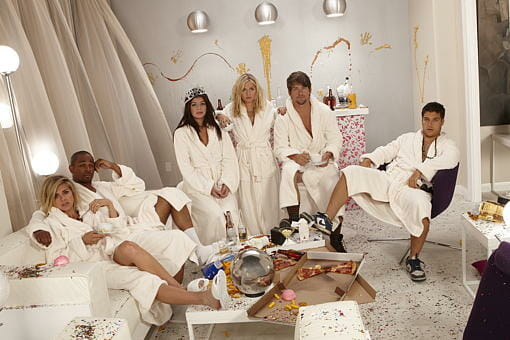By Rachel Langer · October 3, 2011

There are two methods working for half hour comedies these days. The first is a new wave of sharp, witty, occasionally raunchy comedies with a static location, but brilliant and edgy characters. The second method is a lather-rinse-repeat scenario based on a tried and true template. Change up the character names, current events, and toss in some updated tech, and you have a working show. With the first method, a balance is struck between the staleness of a one or two stage set, and the freedom to delve more deeply into the characters and pull out the funny, if the show succeeds with the bare bones, added budget will be tossed into additional sets and characters and the show will build. In the second method, the comedy is far more situational, and the characters remain static; throw them into any new situation and they will react the same way. The show will work until that static hilarity dries up. Happy Endings definitely uses the second method. Essentially, Happy Endings is “Friends” with iPhones and a gay guy, expanding on the model of multi-cast comedy by using over the top scenarios in order to bring the funny.
The Season 2 Premiere starts off with the six cast members lounging in a hotel room, celebrating the one year anniversary of Alex (Elisha Cuthbert) leaving Dave (Zachary Knighton) at the alter. The scene spirals into a crazy mess of anaphylactic shellfish-based shock and accidental leg shucking with an oyster tool, in order to set up the “A” line that Dave has lied to Alex about being allergic to shellfish so that he might avoid her distasteful jambalaya. As the show progresses, the ex-couple’s inevitable lies come to light when they openly discuss each other’s flaws. Jane (Eliza Coupe) finds herself caught in between Alex and Dave, trying to validate them both, all the while agreeing with the other’s distaste for their faults. Penny (Casey Wilson) buys a condo and goes through a crisis, believing she will quickly turn into a crazy cat-loving spinster. Max (Adam Pally) confronts Brad (Damon Wayans Jr.) about hanging out with a group of black buddies instead of himself, and retaliates by adopting a circle of gay friends.
Happy Endings is notorious for cracking jokes and spinning dialogue at lightening speed, putting even the quick witted Gilmore Girls to shame, and with a cast of six major players instead of two. The problem with the premiere, however, is that the only funny part was the dialogue. Each story line felt moderately rushed, lacking flow from one sequence to the next. If it wasn’t for sharp lines hurled at the viewer with reckless abandon, the substance of the episode would have been moderately depressing. Though comedy is generally about making the unfunny funny, there has to be more than quick wit to breathe life into an otherwise macabre topic.
The premiere suffered from the Quentin Tarantino syndrome: dialogue-heavy and light on action. There was very little satisfaction as each storyline was solved neatly with a pat answer and a pat on the back. But where Tarantino knocks the dialogue out of the park, and backs it up with well-timed significant action, this episode gave the distinct impression of riding the bus with a group of high-schoolers who may have avoided their morning dose of Ritalin. The episode lost me completely when Max accuses Brad of spending all his free time with his other friends, and Brad responds by justifying his behavior, until they hug it out. No shred of remorse or change: a one-sided conflict without a resolution, and little – if any – humorous payoff. A C plot should be almost completely humorous and resolutely resolved by the end of the episode. Its sole purpose is to balance out the other two plotlines with an interesting or hilarious side story.
Modeled on the backs of hit multi-character sitcoms like Friends, and How I Met Your Mother, Happy Endings hasn’t quite found a niche between the old and the new wave, and still has some choppy waters to navigate when it comes to balancing dialogue with action. The recycled scenarios reminded me of all the other multi-cast sitcoms I’ve watched, just played in high speed. Happy Endings has potential, and is clearly sitting on a gold mine of funny with a group of extremely witty writers. My hope is that they can balance the funny with the frank, and not set their audience adrift.